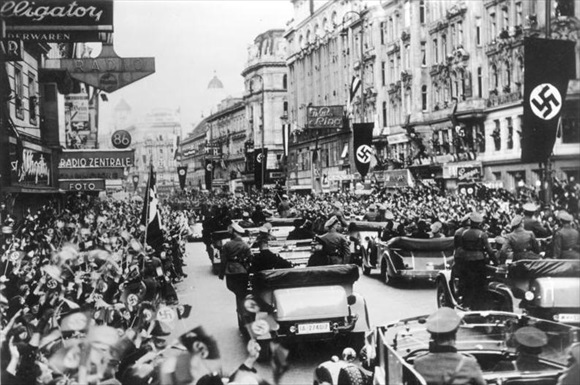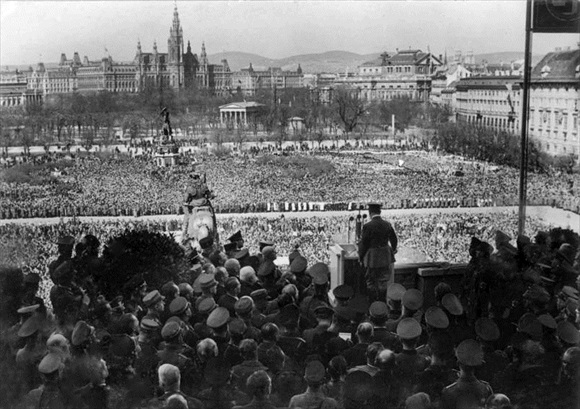HITLER, MUSSOLINI DISCUSS AUSTRIA’S FUTURE
Munich, Germany · September 25, 1937
On this date in 1937 Italian strongman Benito Mussolini paid his first visit to Germany, meeting Adolf Hitler in the Fuehrer’s private, luxurious 9‑room apartment in Munich, 10 minutes away from the Brown House, Nazi Party national headquarters, and the Fuehrerbau, where Hitler had formal offices. During the visit Mussolini made Hitler an honorary corporal of the Italian Fascist militia, while Hitler conferred the Iron Cross of Greater Germany on Mussolini. The meeting of the 2 former World War I corporals included a secret understanding regarding Austria, the tiny country (6.75 million people in 1937) that lay between them. Hitler made his guest aware that Italy’s acceptance of his scheme to gobble up Austria (the so-called Anschluss, or union) was a precondition of their 2 nations’ continued friendship and the formalization of their 1936 Rome-Berlin Axis coalition. For his part, Il Duce (Italian, “the leader”) was ready to accept Anschluss so long as Hitler notified him in advance. Hitler kept his word, apprising Mussolini of Germany’s upcoming annexation of Austria in a letter dated March 10, 1938, just 2 days before Nazi troops surged over the international border.
Mussolini had recently grown tired of being Europe’s guardian of Austrian independence. Four years earlier Mussolini had taken the murder of his friend and Austrian chancellor Engelbert Dollfuss by Austrian Nazis as a personal affront. Mussolini told the Austrian vice-chancellor, who had come to arrange a meeting between the Duce and Dollfuss’s successor, Kurt Schuschnigg, that he knew “the Reich chancellor [Hitler] had ordered the murder of Dollfuss.” He despised Hitler: “A dangerous madman, a revolting individual, a sexual degenerate.” Mussolini predicted that Hitler “will create an army, will rearm the German people, and go to war, perhaps in 2 to 3 years. I can’t hold him off by myself.” (Mussolini got most of it right.)
Mussolini floated the idea of a multinational treaty that would guarantee Austrian independence, but it was rejected by Schuschnigg when the 2 men met in August 1934. One alternative—Italian troops on Austrian soil—made Schuschnigg nervous: “Politically unacceptable,” he told an irked Mussolini, who went on to suspend clandestine arms shipments to the Austrian armed forces that were designed to prevent a second Nazi coup from succeeding. Mussolini now redirected Italy’s geopolitical attention from north of his border to the south and east, to Northeast Africa (Second Italo-Ethiopian War, 1935–1936) and the Mediterranean area (Spanish Civil War, 1936–1939). Poor Schuschnigg. He and the majority of his countrymen failed to fully appreciate the steps the Austrian-born German chancellor could and would take to bring Austria into the Nazi firmament. For Schuschnigg personally, these included his arrest and internment in Sachsenhausen, then Dachau concentration camps after Mussolini had abandoned Austria to the Nazi predator in their Munich meeting. Mussolini now regarded Schuschnigg’s Austria “as a German Austria that could conduct no policy other than a German one.” When columns of goose-stepping jackboots, cannon, and armored vehicles entered Vienna, Austria’s capital, in March 1938, an aggressive pan-Germany was born.
Austria, March 1938: The Return of Provincial Son Adolf Hitler
 |
Above: Tens of thousands of Austrians lined Vienna’s streets hours before Hitler’s motorcade entered the capital on Monday, March 14, 1938. Hitler had followed his army’s entrance from Bavaria into Austria on Saturday, March 12, visiting his birthplace, Braunau am Inn just over the German border, before arriving that evening to an enthusiastic welcome in Linz, Austria’s third-largest city. Hitler’s travels eastward were turned into a triumphal tour that climaxed with his speech in Austria’s capital on Tuesday, March 15, 1938. “Not as tyrants have we come, but as liberators,” he told his audience.
 |
Above: A crowd estimated at 200,000 gathered in Vienna’s Heldenplatz (Heroes Square) to hear Hitler say: “The oldest eastern province of the German people shall be, from this point on, the newest bastion of the German Reich.” The Anschluss was given immediate effect by a legislative act, subject to voters’ ratification. A plebiscite was held on April 10 and approved by 99.7 percent of the voters, but not before 70,000 people had been arrested, and not before a huge propaganda campaign had had its effect, and not before some 400,000 people (nearly 10 percent of the eligible voting population) had been disenfranchised. Those unable to vote were chiefly former members of left-wing parties and Jews (200,000 in Vienna alone). Austria became the German province of Ostmark, its once-vibrant capital eventually turned into a drab provincial town.
Big Fish Swallows Little Fish: Austria Becomes Part of Hitler’s Greater German Reich
![]()

 History buffs, there is good news! The Daily Chronicles of World War II is now available as an ebook for $4.99 on Amazon.com. Containing a year’s worth of dated entries from this website, the ebook brings the story of this tumultuous era to life in a compelling, authoritative, and succinct manner. Featuring inventive navigation aids, the ebook enables readers to instantly move forward or backward by month and date to different dated entries. Simple and elegant! Click
History buffs, there is good news! The Daily Chronicles of World War II is now available as an ebook for $4.99 on Amazon.com. Containing a year’s worth of dated entries from this website, the ebook brings the story of this tumultuous era to life in a compelling, authoritative, and succinct manner. Featuring inventive navigation aids, the ebook enables readers to instantly move forward or backward by month and date to different dated entries. Simple and elegant! Click 











